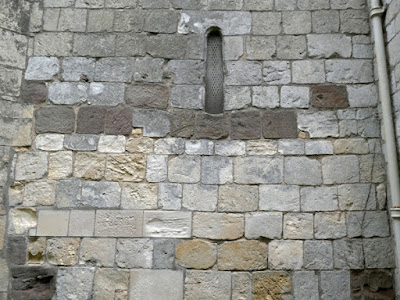 |
| Corbels on the nave |
When alighting from the No. 10 bus at the Edlington Lane/Back Lane stop in Old Edlington, several minutes late, it had started to rain and I immediately set about taking a set of 83 general record photos of the interior of St. Peter’s church, which took 26 minutes.
This left me approximately 25 minutes to photograph the exterior of the church and a couple of buildings for the British Listed Buildings Photo Challenge, before the next bus to Doncaster was due to arrive. Usually this wouldn’t be a great problem, but the rain had got heavier and I had to take photographs with one hand while holding an umbrella with the other, which meant that I was unable to take a really good look at the fabric.
Starting at the tower, the lower stage dates to the late C12 and the Corpus of Romanesque Sculpture in Britain & Ireland (CRSBI) describes the string course, with semi-circular scallops, which separates it from the C15 Perpendicular Gothic belfry stage.
The church is built from dolomitic limestone from the Permian Cadeby Formation, which varies in colour from pale cream to yellow – as seen in the interior and in the diagonal buttresses – and has not proved particularly durable, with sections of the masonry repaired at various times.
I was particularly interested to see that the lowest two courses of the tower and several blocks at the level of the slit window, as well as isolated others on the west elevations of the tower and nave, are a dark red/brown/purple sandstone that is very weathered and which I immediately thought is the Rotherham Red variety of the Mexborough Rock.
Having just revisited Hooton Roberts to look at its historic buildings and outcrops of a very similarly coloured sandstone – marked on the British Geological Survey map as an unnamed Pennine Upper Coal Measures Formation (PUCMF) sandstone – it is a possibility that these were obtained from reddened PUCMF sandstones that often occur immediately beneath the Carboniferous-Permian unconformity.
The geological memoir mentions a few locations around Edlington, Clifton, Micklebring and Conisbrough where reddish/purple sandstone has been found but, although I have investigated several villages that are set on the PUCMF in this part of South Yorkshire, I have yet to find any quarries or rock outcrops where completely reddened sandstones can be seen.
The size, shape and profiles of the blocks of red sandstone at St. Peter's church, which includes those in the nave and chancel, look no different to the surrounding unrestored blocks of limestone, which are presumably part of the original late C12 masonry – as seems to be agreed by Pevsner, Historic England and the CRSBI – but none of these authorities make any mention of the choice of stone, which I think is an anomaly.
Since starting my investigation of the mediaeval churches of South Yorkshire at St. Helen's church in Treeton, which is built in the Rotherham Red sandstone with Permian limestone used for the arcade and external dressings, I have visited many churches that are set on or very near to the Magnesian Limestone in Rotherham and Doncaster.
Except for St. James' church in High Melton, which is mainly built in yellowish sandstone that has some red variation, the only churches on the Cadeby Formation where I have encountered red sandstone, are All Saint's church in Laughton-en-le-Morthen and St. Helen's church in Burghwallis - both of which are Anglo-Saxon - which P.F. Ryder and Paul Buckland consider to be the Rotherham Red variety of the Mexborough Rock.
Old Edlington is set on the Cadeby Formation, which has provided the stone for late C12 churches at Braithwell and Wadworth in the immediate area and this stone has been often been transported a considerable distance - as seen at Treeton and Norton in Sheffield – so I can't think of a good reason why the Norman builders would use any red sandstone in the construction of the church, unless it has been recycled from a pre-existing structure.
Apart from the use of red sandstone, I was particularly interested to see the corbel tables on the south side of the nave and chancel, which the CRSBI describe in some detail. I had seen these only twice before at St. John's church in Adel, near Leeds, and at St. Benedict's church in Lincoln.
Many of these are highly weathered and the details can't be made out but, with the rain continuing to fall heavily, I just concentrated on trying to make a decent general photographic record as I walked around the church, without making any attempt to study their details.
Continuing in an anti-clockwise direction around to the east end of the chancel and the north aisle, there are no more examples of red sandstone blocks in the walling to see and the corbel tables are enclosed inside the church.
I completed my quick look at the exterior at the north elevation of the north aisle, which has two extremely large buttresses that are completely out of proportion to the wall that they are presumably designed to support.
 |
| Buttresses on the north aisle |














No comments:
Post a Comment